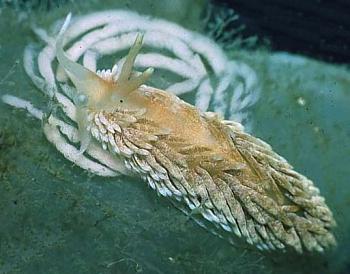

Aeolidiella glauca
(Alder & Hancock, 1845)
Order: NUDIBRANCHIA
Suborder: AEOLIDINA
Family: Aeolidiidae
DISTRIBUTION
British Isles, Denmark to France.
PHOTO
UPPER: Reagh Is., Strangford Lough, N. Ireland - 22 Jun 1976. LOWER: Newquay, Co Clare, Ireland - 30 May 1982. PHOTOS: Bernard Picton.
Grows to about 40mm long, and feeds on a variety of sea anemones. It is hard to differentiate in shape and colour from A. alderi, but it has a quite different reproductive behaviour with A. glauca having planktotrophic larval development while A. alderi has direct development, with no planktonic larval stage. See Bernard Picton's message differentiating A. alderi, A. sanguinea and A. glauca.
Reference:
• Thompson, T.E. & Brown, G.H. (1984) Biology of Opisthobranch Molluscs, Vol 2. Ray Society: London.
Rudman, W.B., 1999 (August 22) Aeolidiella glauca (Alder & Hancock, 1845). [In] Sea Slug Forum. Australian Museum, Sydney. Available from http://www.seaslugforum.net/find/aeolglau
Related messages
Aeolidiella glauca? from northwest Spain
November 30, 2009
From: Jose Garcia Santiago
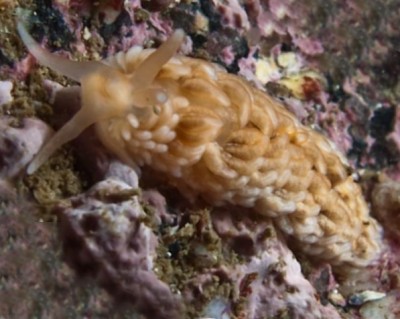
Hi Bill:
I've discovered your site weeks ago and I'm very enthusiastic about it. Here are some photos of a slug that might be Aeolidiella glauca, but I'm not completely sure.
I took this specimen home and kept it for some days for observation and could observe a curious thing. On two occasions the animal secreted like a silk filament as if it was a spider and hung from this structure. The first time was just when I got home, and it remained hanging from the top of the glass bottle in which I had kept it. The second time was more than a week later, after changing the water of the container. Then I put a fucus algae into the bottle and the silk fiber was hung from it. This filament was created from the pointed tail of the animal.
Locality: Ría de Arosa, Ribeira, about 10 meters, La Coruña, Spain, Atlantic coast, 7 november 2009, rock floor under a rocky vertical wall onto which there were some Actinia equina. The animal was stuck into an empty mussel shell.. Length: about 15-20 mm. Photographer: Jose Garcia Santiago
Have you ever seen or heard something like this?.
Congratulations for your site.
Jose Garcia Santiago
josegarciasantiago@gmail.com
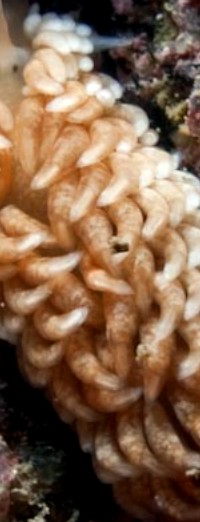
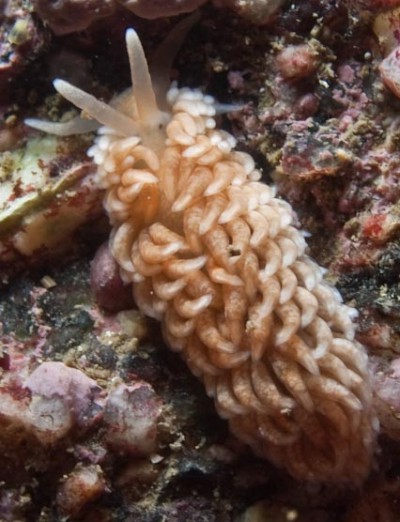
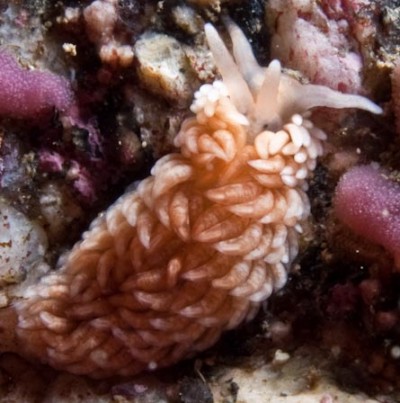
Dear José,
European species of Aeolidiella are quite difficult to identify from photos unless their very special characters can be seen [see Bernard Picton's message #3845]. For example A. alderi is easy to identify when the first row of cerata are white, but sometimes it is hard to tell. In your animal the first row of cerata certainly appear to be quite whitish but on looking closely I am pretty sure there is brown digestive gland pigment visible in some of the larger cerata, which suggests it is not A. alderi. Bernard Picton says that a good character of A. glauca is the pale whitish pigment patches on the cerata which we can certainly see in your photos. On those grounds I think we can be fairly confident that this is A. glauca.
In Cervera et al (2006) A. glauca is recorded from Portugal, Straits of Gibraltar and the Mediterranean coast of Spain but not from the Atlantic coast of nthn Spain, so this may be a new, if not unexpected, record.
Concerning the 'spider-like' thread. All sea slugs produce a mucus which helps them crawl along, much like the slime trail in land snail. The mucus is produced by special gland cells in the base of the foot. Some have uniform gland cells and others have a special glandular region. I am not sure if Aeolidiella glauca has specialised region. Some species, especially those living in places with large water movement can produce a particularly sticky mucus which they use - much like a mountain climber's safety rope - to stay attached to the substrate. Sometimes when on algae or at the end of a rock they will suspend themselves in the water on their sticky mucus much as you describe. It allows them to go 'adventuring' always with the chance of getting back to safety.
Best wishes,
Bill Rudman
Aeolidiella glauca - feeding observations
November 26, 2002
From: Mike Noren


Dear Bill,
Following on my earlier message, I've recently visited Tjärnö marine biological station, Sweden, to photograph flatworms, but I also had the opportunity to photograph what I believe is an Aeolidiella glauca eating the anemone Sagartiogeton viduatus.
The first image shows A. glauca in the act of eating the anemone, the second is a shot of the same slug after removal from the aquarium. It was approx. 30mm long.
The eelgrass anemone, S. viduatus, is a scandinavian endemic, and is probably the most common shallow-water anemone at Tjärnö. According to the staff at the station the A. glauca population closely tracks the S. viduatus population, in what appear to be a classic predator/prey pattern.
Mike Noren
michael.noren@zoologi.su.se
Noren, M., 2002 (Nov 26) Aeolidiella glauca - feeding observations. [Message in] Sea Slug Forum. Australian Museum, Sydney. Available from http://www.seaslugforum.net/find/8469Thanks Mike,
Bill Rudman
Aeolidiella glauca f rom Sweden
December 17, 2001
From: Mike Noren

The slug on the picture was collected at Tjärnö on the Swedish west coast late November. It's about 15-20mm long. Unfortunately I do not know for certain what it was collected from, or even what depth, although it probably came from a sample of red algae with abundant bryozoans, hydroids, sponges and ascidians, with some Alcyonium soft corals thrown in for good measure, collected at about 15 - 8m depth.
My best guess as to identity is Cuthona nana?
Mike Noren
mike_noren@hotmail.com
Noren, M., 2001 (Dec 17) Aeolidiella glauca f rom Sweden. [Message in] Sea Slug Forum. Australian Museum, Sydney. Available from http://www.seaslugforum.net/find/5829Hi Noren & Bill,
This is Aeolidiella glauca - note the big eyes, chunky appearance, rhinophore pigmentation, ceratal pigmentation, ceratal arrangement
Bernard Picton
bernard.picton.um@nics.gov.uk
Aeolidiella glauca from Holland
September 6, 1999
From: Peter H. van Bragt
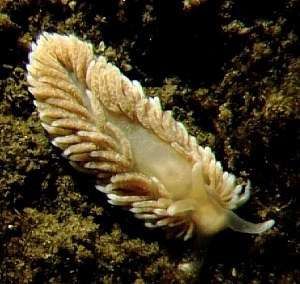
Dear Bill,
Here is a photo of Aeolidiella glauca to add to the Netherlands' List.
Location: De Veerweg, Tholen, Oosterschelde, The Netherlands, 18 April 1999
With best regards,
Peter H. van Bragt
Peter.vanBragt@ftn.hsbrabant.nl
van Bragt, P.H., 1999 (Sep 6) Aeolidiella glauca from Holland. [Message in] Sea Slug Forum. Australian Museum, Sydney. Available from http://www.seaslugforum.net/find/1231Thanks Peter,
Bill Rudman.
